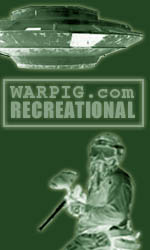  |
|
|
|
|
|
|
  |
|
|
|
|
|
|

What do you think? Add your comments in WARPIG's REC TALK Forum |
Duncan's Games
Hambleton's story, and the stories of those involved in his rescue has been the subject of a best selling novel, untold numbers of news articles, a major motion picture, and most recently, the inspiration for a scenario paintball game.
Over 300 players came out, and were divided into teams representing American and North Viet Namese forces. “ORJester” of team Orbital Reign in Tampa, FL filled the roll of general of the US troops, while “Meltdown” from Team Outkast in Palm Bay, FL led the NVA. Local team Osceola Raiders and the Black Berets from Old River Paintball in Ocala, FL served as the game's referees. The event drew players from throughout the southwest, and even further. Game promoter Kerry “Viper” Rosenberry made the trip out from Texas to take part..
When the real Colonel Hambleton was communicating with his would-be rescuers, his love of golf came into play. To encode his position and travel plans, he described terrain and directions using the layouts of famous golf courses. The golfing theme was not lost on Duncan as he laid out the game. Each general was given a set of golf clubs, and one of their challenges was to get a handful of golf balls from a starting point to a goal, using “their best skills.” Similarly the official field map was laid out with golf course greens, the understanding of which was critical to the completion of key missions. |
| Copyright © 1992-2019
Corinthian Media Services. WARPIG's webmasters can be reached through our feedback form. All articles and images are copyrighted and may not be redistributed without the written permission of their original creators and Corinthian Media Services. The WARPIG paintball page is a collection of information and pointers to sources from around the internet and other locations. As such, Corinthian Media Services makes no claims to the trustworthiness or reliability of said information. The information contained in, and referenced by WARPIG, should not be used as a substitute for safety information from trained professionals in the paintball industry. |